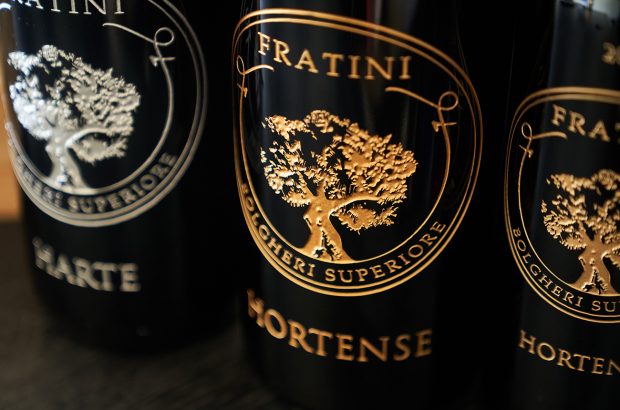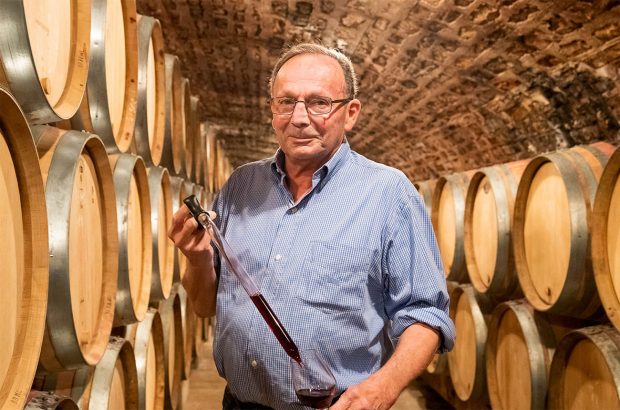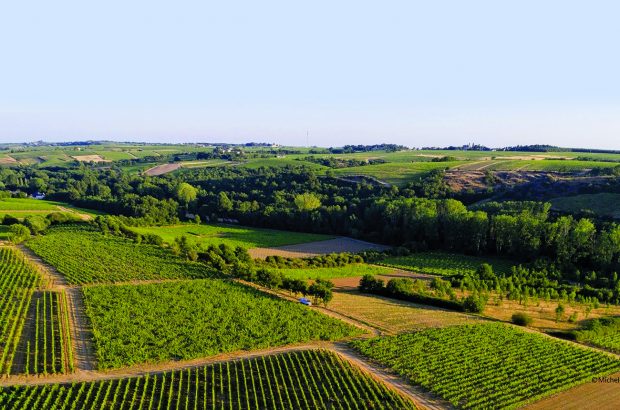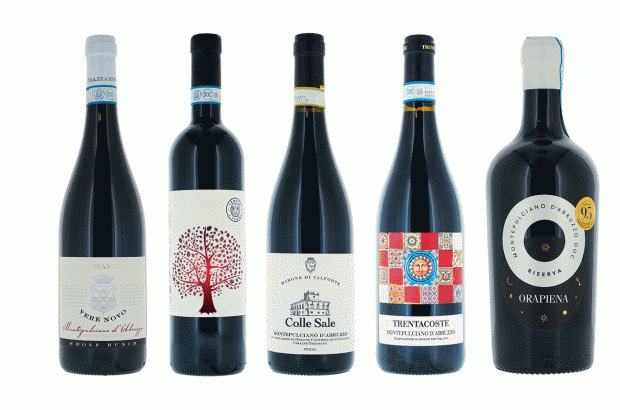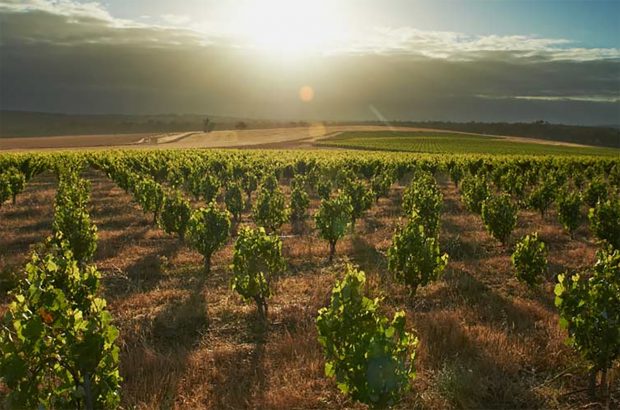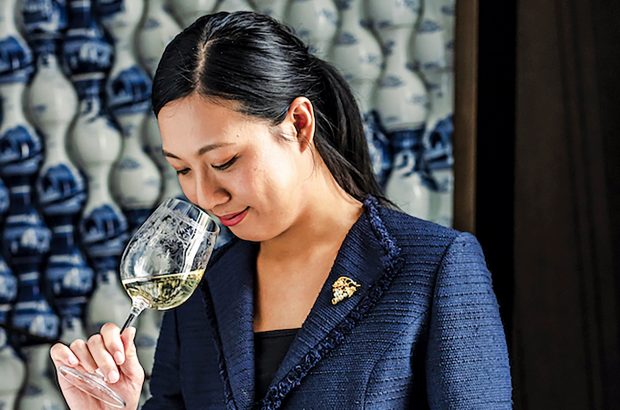- A widening breadth of styles among individual domaines.
- High sugar levels and consequently naturally powerful wine.
- Syrah and Mouvèdre provide added complexity and structure.
- A blended wine is requisite is order to balance the excesses of nature.
Châteauneuf-du-Pape is an appellation of potent images and features. Cypress trees bowed by the force and persistence of the Mistral wind, a terrain carpeted with rounded, smooth-faced stones or galets roulés and bottles embosed with the papal coat of arms are but a few. The most idiosyncratic, though, must be the decree enabling vignerons to use 13 different red and white grape varieties in the production of the wine.
In face value terms this allows for an incredible range of styles of wines depending on the permutation of varieties selected by each individual producer. In real terms one grape variety, Grenache, has dominated the scene for most of the century, imposing it’s big, warm-hearted flavours on the style of Châteauneuf-du-Pape. Today, Grenache still accounts for 75 per cent of the 3,200 hectares (ha) under vine but little by little has given ground to other varieties, most notably Syrah and Mourvèdre. The input of these cépages has widened the breadth of styles among individual domaines and must be seen as a positive factor in the general evolution of the appellation.
Historic references are vague but Châteauneuf’s 13 permitted grape varieties (Grenache, Syrah, Mourvèdre, Counoise, Cinsaut, Muscardin, Picpoul, Terret, Vaccarèse, Bourboulenc, Clairette, Picardin, Roussanne) probably all existed in the region prior to the outbreak of phylloxera in 1870. Some, like the Muscardin and Vaccarèse, appear to be indigenous, while others made a migratory passage to Châteauneuf-du-Pape. Grenache and Mourvèdre arrived from Spain sometime during the late 18th or early 19th centuries, at the same time as Syrah from the northern Rhône. The assumption is that mixed planting was much more common at this time and that different varieties were used to offset problems caused by a climate that nurtured spells of drought and a fairly turbulent wind pattern.
During the post-phylloxera period of reconstruction of the vineyard a more defined idea of the grape varieties available and their relative values was given by Commandant Joseph Ducos, owner of Château La Nerthe. Following experiments with 10 different varieties, he devised his ideal formula for blended wine: 20 per cent Grenache and Cinsaut for ‘mellowness, warmth and consistency’, 40 per cent Mourvèdre, Syrah, Vaccarèse and Muscardin for ‘structure, ageability, freshness and a thirst-quenching taste’, 30 per cent Counoise and Picpoul for ‘vinosity, pleasure, freshness and bouquet’ and 10 per cent of the white grapes Clairette and Bourboulenc for ‘vigour, finesse and sparkle’.
It is very interesting to note that Commandant Ducos proposed only 20 per cent Grenache (vinified with Cinsaut) in his blend and that this grape later became the appellation’s pre-eminent variety. Grenache has two attractive features for growers. As a bush-trained plant it takes reasonably comfortably to hot, dry, windswept vineyards. It also produces grapes with high sugar levels and consequently naturally powerful wines. The latter proved appealing to Burgundian merchants seeking to bolster their own meagre offerings and from the 1930s through to the 1960s this ready market dictated the spread of Grenache in the vineyards. The Grenache phenomenon continues to play a role in the widespread disparity of quality in Châteauneuf today. The down side of this variety is that unless picked at a decent level of maturity it produces rather bland vines of a hot, sweet, rustic nature that have a tendency to oxidise early. While the fashions of winemaking may change (carbonic maceration has virtually been and gone) it is still all too easy for the less conscientious grower to achieve the obligatory 12.5 per cent alcohol with Grenache without the requisite maturity of fruit. Bottled by the same producer or a négociant (the latter accounting for the commercialisation of 50 per cent of the appellation’s production), often without the addition of a more structured grape variety, the Châteauneuf label is assured but the quality level is compromised.
This is not to say that rich, round, concentrated wines with exuberant fruit and good ageing potential cannot be obtained from Grenache. As Château Rayas has proved over the years, the secret is low yields and harvesting at the correct level of maturity. ‘If you pick at the optimum level of ripeness the wine will be balanced, even with an alcohol potential of 14–15 per cent,’ says Emmanuel Reynaud, who since 1997 has assumed the management of this mythic family domaine. The wines continue to be made from 100 per cent Grenache, with yields kept well below 20 hectolitres per hectare (hl/ha) (the appellation limit is 35hl/ha) by severe pruning and green harvesting in the summer months. Rayas is also usually one of the last to harvest. The 12ha vineyard, a single homogenous unit, is north facing and located on sandy soils without any of the famous galets roulés to radiate thermal heat. Consequently, the ripening cycle is slower and longer.
A more youthful enterprise, producing quality wines essentially from Grenache, is the Domaine de La Janasse at Courthézon. Created by Aimé Sabon in 1976, the domaine is more typical of local properties with its 12ha of Châteauneuf-du-Pape carved into 20 different parcels of vines spread throughout the varying terroirs of the appellation. Three different cuvées are produced: Tradition, Chaupin and Vieilles Vignes. Restricted yields remain a central part of this domaine’s philosophy. To this has been harnessed some reflective, innovative winemaking following the arrival in 1991 of Aimé’s son Christophe, having completed his viticultural studies in Beaune. A major part of the harvest is now destemmed and in 1996 pigeage was introduced for a better extraction of the tannins. ‘Grenache has plenty of fruit and substance but, like Pinot Noir in Burgundy, it needs to be worked,’ explains Christophe Sabon. Following a vatting period of 15–25 days, the wine goes directly into a mixture of oak barrels and foudres to complete the malolactic fermentation. The wines are then aged for a further 12 months in wood and three to four months in tank before being bottled.
Whereas the Sabons have managed to remain true to Grenache and avoid rusticity and heavy alcohol on the finish, others have reduced the percentage of this grape for exactly these reasons. ‘In exceptional years like 1990 and 1995, when there is perfect maturity, pure Grenache can be very good, but, generally speaking, it is too alcoholic and evolves rapidly,’ says Paul Avril of the Clos des Papes. He started the search for a better, more balanced wine back in 1976 by planting more Syrah and Mourvèdre and now has all 13 varieties planted on the terraced slopes behind Châteauneuf’s ruined papal castle. Syrah (12 per cent) and Mourvèdre (20 per cent), however, have proved the mainstay of the Clos des Papes blend with Grenache reduced to 60 per cent. In general, producers have turned to Syrah and Mourvèdre to provide added complexity and structure in their wines. The Syrah is employed essentially to add colour, fine tannins and red berry fruit aromas, but not all are convinced of its attributes in the southern Rhône. ‘It does not have the same complexity and finesse as in the northern Rhône,’ says Christophe Sabon. At the biodynamically run Domaine de Marcoux, winemaker Sophie Armenier is equally unconvinced: ‘Syrah changes the style of the wine too much in the southern Rhône and needs to be used sparingly.’ Only 3 per cent is added here to an 80 per cent Grenache based wine.
The Domaine du Vieux Télégraphe, like the Clos des Papes, however, has been won over by Syrah and uses 15 per cent in the blend along with 65 per cent Grenache. ‘It livens up the composition of the wine,’ says Vieux Télégraphe’s Daniel Brunier. Both domaines are equally convinced by the qualities of Mourvèdre. As mentioned above, Clos des Papes uses up to 20 per cent in its blend and Vieux Télégraphe 15 per cent from old vines nearing 40 years of age. In addition the Bruniers recently planted another hectare and have some young vines (15 years old) which are presently used in the second label, Vieux Mas-des-Papes. This variety, perhaps more than any other, provides the essential foil to the heady, unctuous qualities of Grenache, offering a firm, tannic (anti-oxidative) structure, dense texture and additional aroma. The problem is that as a late ripening variety it is hard to bring to perfect maturity, needing both sunshine and an adequate supply of moisture or as they say in Châteauneuf ‘its head in the sun and feet in water’. ‘Mourvèdre is not easy to grow and therefore needs to be carefully sited, but when fully ripe, as in 1996 and 1997, it becomes an integral part of the blend,’ says Avril. It is in workmanlike, average to good vintages like these that Syrah and Mourvèdre provide an extra dimension.
In terms of the reconstruction of vineyards and consequent transformation in the style of wine, nowhere has the change of direction been more clear than at Commandant Ducos’ ancient estate, Château La Nerthe. When Alain Dugas arrived to manage the property in 1985, Grenache dominated to the tune of 85 per cent. He swiftly replanted 15 of the 65ha, reducing Grenache to 55 per cent with a complement of 18 per cent Syrah, 20 per cent Mourvèdre, 5 per cent Cinsaut and 2 per cent of the other varieties. ‘I studied Ducos’ arguments and was convinced by his line of thought,’ explains Dugas. As is the tradition in Châteauneuf, a number of the grape varieties, Grenache and Mourvèdre for instance, are vinified together for added complexity. The respective ripeness of each variety is the important factor, with Mourvèdre being pruned early in November thereby advancing maturity by a week.
Yields are held to an average 25hl/ha, the grapes destemmed and vinification carried out mainly in temperature controlled stainless steel tanks, although wooden vats are slowly being introduced. The wines are then aged in a mix of barrels, foudres and tank. ‘The tannins of the Mourvèdre need to be rounded out in small oak barrels,’ says Dugas. The wines are full-bodied but refined, with soft tannins, supple texture, red-berry fruit aromas and a freshness on the finish. In certain years, a special Cuvée des Cadettes is released. In 1995 this was made from a blend of 60 per cent Grenache, 30 per cent Mourvèdre and 10 per cent Syrah aged in new oak barrels. Dugas also produced an experimental Cuvée Joseph Ducos in 1995 following the Commandant’s recipe for Châteauneuf-du-Pape and is persistently monitoring its evolution. If Grenache, Mourvèdre and Syrah are the mainstay of the appellation, the other 10 varieties appear almost anecdotal. The white varieties Roussanne, Clairette and Bourboulenc, along with Grenache Blanc, are mainly reserved for the tiny production of white Châteauneuf-du-Pape (5 per cent to 6 per cent of an average yearly production of 100,000hl). For the reds, figures available indicate that varieties like Terret represent only 0.02 per cent of plantings and Vaccerèse 0.13 per cent, and these probably exist co-planted with Grenache. Only at one of the rare estates like Château de Beaucastel, where all 13 varieties are cultivated and vinified separately, is it possible to assess some of Châteauneuf’s more offbeat varieties.
Château de Beaucastel has for long ploughed its own course and remained the most consistent and original of wines in Châteauneuf-du-Pape. Grenache occupies only 30 per cent of the blend to which (with a slight variable according to vintage) is added 30 per cent Mourvèdre, 10 per cent Counoise, 10 per cent Syrah, 5 per cent Cinsaut and 15 per cent other varieties including the slightly musky scented Muscardin. ‘This is a region of climatic contrasts, hence a blended wine is requisite in order to balance the excesses of nature,’ explains François Perrin who along with brother Jean-Pierre runs this 100ha estate. The Perrins prefer a firm, square structure to their wines, hence the emphasis on Mourvèdre and Counoise. The latter is a late ripening variety unique to the Vaucluse and, from Beaucastel’s 50-year old vines provides colour, texture and fruit with a gamey nuance. The ideal of structure and intensity is pushed to greater heights in years like 1995 when the Mourvèdre reaches perfect ripeness and the Perrin brothers produce the Cuvée Hommage Jacques Perrin from 60 per cent Mourvèdre, 20 per cent Grenache and 10 per cent each of Syrah and Counoise.
Away from the mediocrity Châteauneuf offers a wide range of styles. There is latitude for self expression without losing sight of the intrinsic qualities of the wine. Those producers who have realised this fact are doing the appellation more than just a good turn.







